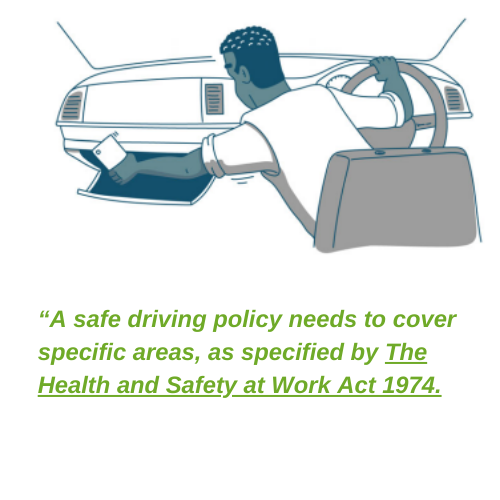 policy needs to cover specific areas, as specified by The Health and Safety at Work Act 1974." width="500" height="500" />
policy needs to cover specific areas, as specified by The Health and Safety at Work Act 1974." width="500" height="500" />A driving for work policy is how your organisation can demonstrate its commitment to minimising road risk. The law says that every business must have a policy for managing health and safety. A health and safety policy sets out your general approach to health and safety. It explains how you, as an employer, will manage health and safety in your business. This must include how you manage the recognised risks around driving for work or driving at work.
Many organisations have mature, robust health and safety commitments and processes, and manage risk within their offices, construction sites, and production and storage facilities really well. But do they ‘get’ that their moral and, indeed, legal responsibilities extend to the road?
If you employ anyone who drives for work, you need a specific driving for work policy. If you’re not sure what should be included, using a driving at work policy template UK is the best way to make sure your policy is legally compliant.
A company driving policy needs to detail your organisation’s rules and expectations regarding the driver, the journey and the vehicle. This includes what you expect of your drivers, and what they can expect from you as the employer.
Under the Health and Safety at Work Act 1974, employers have a ‘duty of care’ to employees. This extends to employees who are driving for work – therefore, your organisation must take steps to understand, assess and minimise risk for anyone who drives for your organisation. In the event of an incident, you could be asked to demonstrate the actions you took to manage risk and fulfil your legal obligations. There have been incidences when employers and managers have not been able to do this – and the repercussions are life changing.
That’s why it’s so important that you follow and implement a driving for work policy example. And it’s not only a legal issue – if you are managing road risk in your organisation well, it brings benefits across the board, including:
The best way to make sure that your policy is up-to-date and fully compliant is using a company driving policy template, like this Driving for Work Policy Builder which helps you build the policy, alerts you of any changes in relevant legislation, and reminds you when it’s time to review your policy.
Your organisation’s driving for work policy should deal with driver distraction. It should detail what constitutes distracted driving, potential consequences if the policy is breached, and what actions are being taken to reduce the risk of distracted driving. It should also state who the policy applies to – this should be anyone who drives a vehicle for work during working hours, even if it’s not a part of their regular role.
It’s essential that you and your employees understand the dangers of distracted driving and why a distracted driving policy matters.
 policy needs to cover specific areas, as specified by The Health and Safety at Work Act 1974." width="500" height="500" />
policy needs to cover specific areas, as specified by The Health and Safety at Work Act 1974." width="500" height="500" />
Having clear and well-communicated rules in place on the use of mobile phones, including the use of hands-free devices while driving, helps to avoid any confusion amongst your drivers and to improve driver safety.
As with any aspect of a company fleet usage and driver safety policy, leading by example is vital. If your organisation states that employees must not take calls while driving, then managers must not call or text drivers during driving hours.
Those in senior positions need to avoid undermining the policy if you want your employees to buy into your organisation’s safety culture.
Safe driving starts with licence checks and comprehensive driver training, and requires all drivers and their managers to understand the company’s expectations and rules on driving for work.
Employers have a legal and moral obligation to minimise risk faced by, and created by, their employees. That means making sure that every employee who makes a work-related journey during working hours is fit to drive and safe to do so, to protect them and other road users.
Driving for work is one of the most dangerous activities an employee will do, and it needs to be treated as such. If an employee isn’t fit to drive, they must not do so – no matter how important the journey is. Fitness to drive is a broad term which covers:
All of these factors can have a significant influence over an employee’s ability to drive safely and without distraction. Your organisation’s driving for work policy should deal with all of these factors to protect both your employees and the organisation itself, in terms of your legal duties.
Creating a driving for work policy doesn’t have to be complicated – there are free tools available online to help.
This Driving for Work Policy Builder offers a template that you can fill in with details specific to your organisation. It covers all of the relevant sections, and will update you if legislation changes – so you and the directors of your organisation can have peace of mind that your driving for work policy is fully compliant at all times.